Robert Knox's Blog, page 2
April 14, 2023
The Garden of History... American Revolution? Boston's Samuel Adams Brought More Than the Beer
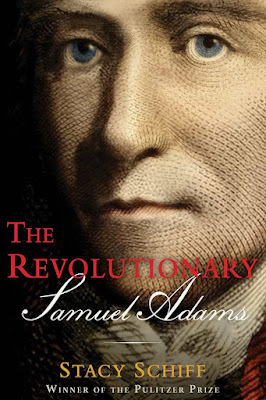
The recent biography “The Revolutionary Samuel Adams” by Stacy Schiff changed my understanding of the American Revolution, a topic I had considered myself pretty well-versed in. It also exposed today’s general ignorance (and my own) of the role in the revolution played by Samuel Adams. Everybody, certainly in Boston, knows the name, and in recent decades everybody everywhere knows the name of the beer company. But I suspect even among residents of the city where the revolution began, few who walk past Samuel Adams’ grave in a tiny cemetery in the city’s center have little appreciation for the starring role Adams played in a drama that changed Western civilization.
I’d have to include myself in that number — before reading this book.
Over the years I’ve have read a number of books about the American Revolution. I’ve read about the America’s War of Revolution. I’ve read books about the ‘the causes of’ the American Revolution.’ However, I suspect, that my mental picture of the events leading to Lexington and Concord in 1775 has been influenced by media depictions of our country’s beginning, going all the way back to a childhood exposure to Disney’s “Johnny Tremain.” When doughty youngster Johnny is quizzed on the need for a revolution, he replies “to protect the rights of Englishmen.” No, the lad is gently corrected by a savvy American patriot in a tricornered hat, “the rights of all men.” But that film starts way too late in the story and focuses on a few headline events: the Boston Tea Party, Lexington and Concord.
Years later, after the dispiriting conflation of “patriotism” with support for the Vietnam War, I found my love for my country’s origins reignited by a film version of the stage musical “1776.” This version of America’s foundation story gave starring roles to John Adams, Thomas Jefferson and Ben Franklin. But after reading Schiff’s book, I see that “1776” also comes way too late to address a deeper issue, the transformation of English-speaking colonials into a new body politic dedicated to civic values such as self-determination and natural rights, including a right to self-government. What the awakening national sensibility in the post-Stamp Act decade called “Liberty.”
And it was the other Adams — not John, the hero of 1776 — but Samuel Adams who got us there. At best, all I knew about Samuel Adams was he the guy who was able (as per the Disney movie) to mobilize the proletariat, the rougher element in town, to dress up like Indians and throw the tea into the harbor. A provocateur with a blue-collar sensibility. So, so wrong. So limited.
While the declaration produced by the Continental Congress, and the war that followed, are essential, foundational events, “The Revolutionary Samuel Adams” takes readers us to the nation’s true, on-the-ground beginnings: the discovery by an underemployed Harvard graduate who’d tried his hand in varied fields, whose beer-making was not a success, that what his city was truly in need of was something we today call a ‘politician.’
“The Revolutionary Samuel Adams” makes a convincing case that Samuel Adams was in fact the essential figure in a generation-long movement that eventually led to nationhood and independence. Schiff notes that Adams’s contemporaries all believed this. Adams, perhaps by way of becoming the essential revolutionary, was also a hell of a tactician, rabble-rouser, political theory thinker and analyst, practical scholar, and excellent writer. Two other firsts, at least in the American vein, are laid to his account: he created the country’s first important local-issues newspaper, and served as its first political journalist.
I will confess to finding, at first glance, the appearance of Schiff’s biography formidable. Its pages present nothing but a blunt series of long third-person passages. The book is almost dialogue free because 18th century records do not preserve spoken speech. How do you build a scene or depict a dramatic moment without verbal clashes? In fact, “The Revolutionary Samuel Adams” is built on perfectly chosen, exacting, ear-perfect snippets of quotation taken from written sources such Adams’s published newspaper essays, dismissive comments in the letters of Colonial or British officials, and the observations of Adams’s American contemporaries. Although not all his papers were preserved, Adams wrote a lot, at time filling columns in Boston’s five newspapers. If someone had proposed building a book this way, I would have said, ‘Nah, it will never fly.’ But this one not only flies, it soars.
After I put down “The Revolutionary Samuel Adams,” I wanted to pick it up and read it over again from the beginning, if only from the pleasure of the prose. Needless to say, the quality and variety of primary source research is staggering. Schiff shows us, step by step, local controversy by local controversy, months turning to years of small-ball maneuvering and careful weighing of positions. And then as controversy yields to crisis, and crisis builds to deeper crisis — as, that is, Britain sends in the taxmen, then sends in the troops — the practical philosopher Adams shepherds his hometown, then his colony — and then extends Boston’s reach to one or two, and finally to all the other colonies — to a clear, principled stand on the need for the protection of liberty achieved by self-government.
Nothing in Adams’s early adulthood suggests he will play this role. A Harvard graduate, Samuel failed to find a successful career. In his early manhood he lost family money investing in the “Land Bank,” a fledging sort of credit union scheme to help create a desperately needed small business credit system for Boston’s small merchants and households. The city’s “merchant elite,” Schiff writes, considered the bank a threat to its own interests and got English officials to the scheme out of business, impoverishing many local families. As economic issues became political issues, setting large elements of the city against the wealthy, crown-oriented figures — especially the colony’s appointed governors Francis Bernard and Thomas Hutchinson — class enemies became political enemies, and ordinary colonists began to question the right of the British Empire, Parliament in particular, to make laws that violated their natural ‘rights’ as citizens.
Adams begins to play the role of breadbasket politician, the book tells us, after being elected tax collector — the kind of job you get when everybody else moves to the other side of the room. The aftermath of the shutting down of the Land Bank meant those who had invested stood to lose their property. Saving his own property acquainted Adams with tactics he will use in other causes. He appeals to the court of public opinion. He discovers legal technicalities to slow the case against him, finds obscure precedents, plays the delay game.
It’s the kind of small-ball game he plays in the years ahead, turning ‘politics’ into a daily, full-time unpaid occupation to build support for the principles that he and collaborators such as James Otis believed in. A tactician playing the long game, the goal of “revolution,” or armed resistance, was not on the table until very late in the game. Instead, “The Revolutionary Sam Adams” shows us retail politician willing to address, tussle, engage, debate and oppose any step taken by Parliament, or by the English government’s appointees and Colonial allies, that he believes infringes on the goal of “the preservation of liberty.”
The conflict over what Boston ‘Americans’ regarded as their rights and what Parliament regarded as its authority intensified when Britain attempted to tax the colonists directly to help offset the cost of the empire’s Seven Years War, that ended in 1763 with the expulsion of France from North America. Parliament saw it as a war to protect the colonies; Americans saw it as an imperial war against a European rival that had gained the empire further territories.
Taxation measures such as the Stamp Act led to American resistance. A later tea tax provoked the famous (or infamous) Boston Tea Party. London responded by sending troops to impose its will on stubborn Colonials. Tensions led to Lexington and Concord, prompting the Continental Congress (which grew from Adams’s invention of “Committees of Correspondence”) to give Thomas Jefferson’s his moment in the sun.
But long before any of that happened, this book tells us how the road to independence and nationhood began in Boston.
In a chapter titled “Nothing Could Have Given Greater Disgust” — Schiff is a connoisseur of the 18th century prose style’s characteristic combinations of ‘correctness’ and blunt content — the author begins: “Here comes Samuel Adams then, a graying widower, inexpensively and unremarkably dressed, familiar with nearly everyone who crosses his path. He is all loose ends and blighted promise. He has held off his father’s creditors, but his house is in disrepair. He has run his malt business into the ground. Charges of financial impropriety cling to him… He could be embarrassed by his brushes with bailiffs, but, cheery and congenial, has elected not to be. He has time to talk.”
And talk did. Also write… The author then notes, “His fortunes will not improve but events are about to meet him halfway… Adams’s improbably ascendancy begins now, in 1764. Soon he will preside over Boston…”
Samuel Adams was always controversial. He always had enemies. He was always busy, turning every issue into a lesson, every development to advantage.
He was a man for the hour. And the hour lasted a dozen years. After which the united colonies declared independence.
Read this book if you wish to know how, historically speaking, thirteen English colonies became the United States.
This book review essay first appeared on Medium.com
To find it there go to Medium.com
https://medium.com/@rcknox2/americas-...
April 13, 2023
Poems for an Up and Down Spring: Shakespeare's Comedy and Real-Life Tragedy
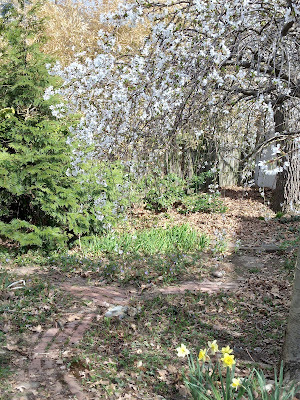
My two poems in April issue of Verse-Virtual consist of a comedy and a tragedy. “In the Country of Fools, the Half-Wit is King” takes off from the Shakespeare quote. The second poem, “Time Stopped” recounts a recent, very different experience.
The issue's theme was based on a quote from Shakespeare's play As You Like It: "the wise man knows himself to be a fool." My poem goes back to that play and takes off from a dialogue between the 'fool' Touchstone (a fool in the Elizabethan sense is an 'entertainer' in a royal court who is allowed to speak truth to a king) and would-be suitor (a 'clown' or country bumpkin in the Elizabethan use of the term).
Here's the poem:
In the Country of Fools, the Half-Wit is King
The second poem, the tragedy, is titled "Time Stopped." It recounts a recent, very different experience. Here's the beginning of
Time Stopped
To read the rest of the poem, here's the link to Verse-Virtual
February 13, 2023
We're Still Waiting for 'American Midnight' to Yield a Dawn
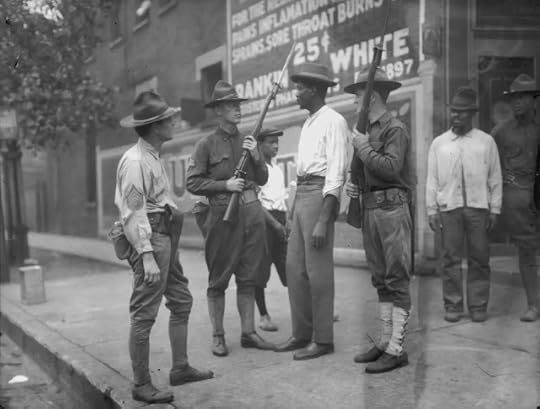
In considering the title of Adam Hochschild’s recently published book, “American Midnight: The Great War, A Violent Peace, and Democracy’s Forgotten Crisis,” it’s those last two words that sting: “forgotten crisis.”
The events described, often in vivid detail, and well analyzed in this book by an author who has written other well-regarded volumes on historical subjects (“King Leopold’s Ghost” and “To End All Wars” among them), took place a century ago. Many of them transpired in a period historians call “The Red Scare,” though Hochschild’s book goes back usefully a few years earlier,” focusing on the years of 1917–1921, to discuss the systematic repression of radical labor movements such as the International Workers of the World and the country’s long-forgotten Socialist Party.
The International Workers of the World (known as the IWW and also as “the Wobblies”) sought to revolutionize labor organizing by collecting all workers into one big union, rather than organizing along trade lines, a practice resulting in small unions that were hopeless underdogs in contests with well-funded, politically connected “trusts” well on their way to becoming monopolies. The American Socialist Party was a vital political party more than a century ago that contested elections in many states, electing enough Congressmen from states such as Wisconsin to pose a viable threat to the two dominant parties that still govern us today. Those parties, increasingly dependent on wealthy donors, took advantage of World War I’s wartime repression to eliminate competition by a party that challenged the right of wealth to rule.
I’ll get back to my own take on “The Red Scare,” the origins of which I believe are slighted by this book, but first let’s take a look at its many virtues and the appalling tale it has to tell of a Constitutional democracy losing its way.
Things were not great for ordinary Americans over a century ago even in the relatively prosperous years between recurrent economic downturns called “panics,” or depressions. The nation’s wealth was concentrated in the hands of a few, its politics dominated by the wealthy and big business, and the impoverished could expect little or no help from the state. And the times, Hochschild tells us, especially for dissenters, immigrants and Blacks, were about to take a decidedly extreme turn for the worse.
The book opens with a detailed account of an attack on union organizers beaten, tarred and feathered for doing nothing but sitting around in a union hall in a town — Tulsa, Oklahoma — whose ruling powers wanted to make sure that neither they, nor anyone who shared their opinions, would ever go there again. In another infamous, widely cited instance, mine workers striking in Colorado were mowed down by National Guardsmen, the dead including women and children.
Until the fever broke (more about that later), the repression of dissent by government and big money, hand in glove, and using any available means — groundless arrests, abridgment of First Amendment rights, targeted violence, and simple murder — went so far beyond the ugliest excesses of the “McCarthy Period” that the dominant lesson of “American Midnight” may simply be how much ‘history’ of the ugly sort can simply be forgotten. Especially the sort of history that runs counter to the preferred myth of a vital, growing democracy rising to meet every challenge history and bad actors elsewhere can produce.
In the years preceding America’s 1917 entry into World War I, this book tells us, critics of the status quo, whether acting singly or as part of an organized body that opposed the status quo consolidation of wealth among the few (and the impoverishment of the many) could expect to be targeted by the forces of money and political power, whether the attack came by the suppression of the freedoms of speech, assembly and press, or through the use of brutal physical force.
President Woodrow Wilson’s decision to join the “allies” and declare war on Germany simply intensified the repression by giving police, courts and vigilantes a new toolbox of repressive laws, and offering ‘patriotic; bigots a new target: Americans of German extraction. Persecution and hatred of Blacks and immigrants, already part of the landscape, was given a new rationalization as well.
Reviews of “American Midnight” have foregrounded the notion that while many see contemporary events such as the rising support for the authoritarian and racist rule modeled by the Trump as an existential threat to democracy, the American political system has faced even worse threats in the past. Further, should we need greater motivation to protect democracy than that provided by current outrages, we should be reminded how truly terrible American right-wing movements can become given their inclination to suppress first amendment freedoms and democratic norms when abetted by crises such as engaging in the first big 20th century war — or, perhaps, a more recent example, the nine-eleven attacks.
It has happened here, the commentators point out. The nation’s recovery from the worst or most blatant of those anti-democratic outrages can also be viewed, optimistic readings of the book’s title suggest, as an indication of democratic America’s resilience.
We can judge for ourselves how valid those perspectives are, but let’s first take note of a few this book’s well told and widely researched presentation of the many instances of how unthinkably bad things can get. Let us count the ways.
We can find instances on almost any page. In 1917, the nation’s “domestic military intelligence chief” — think about that title — a thing of darkness named Ralph Van Deman considered “any threat of Black advancement” a danger to America, so Hochschild tells us. Van Deman advised his minions that “it has become evident” that German agents “were circulating among the Negro people.” In reality, of course, no such circulation was taking place. But a racist fear can fuel intensified persecution. To Van Deman “and the millions who thought like him,” Hochschild writes, “Blacks defending their rights in any way were the cause for immediate suspicion.” And given wartime paranoia and wartime laws weakening everyone’s civil rights, the persecutors were given authority to surveil and threaten Black leaders and organizations. Threats have consequences. After warning “The Chicago Defender,” a Black newspaper that its reports of lynchings and acts of voters suppression throughout the country were creating “disloyalty,” the newspaper changed its tune, and its coverage, to praising Black soldiers and urging readers to buy Liberty Bonds.
Reporting to bigwigs in the “Justice Department” — an especially Orwellian contradiction in terms in this period — the domestic military intelligence chief sent spies to investigate the minister of the Ebenezer Baptist Church in Atlanta, a strong advocate for Black suffrage. The pastor’s grandson, Dr. Martin Luther King, would later get the same treatment from Hoover’s FBI.
Hochschild’s “American Midnight” era, unsurprisingly perhaps, gifted the country with J. Edgar Hoover and what would become the FBI, an agency explicitly created to investigate left-wing organizations or any groups supporting causes we now call “progressive.” And after Wilson, who had been re-elected on the slogan ‘he kept us out of war,’ decided to lead his country into The Great War in April of 1917, the wealthy and the well-connected used the excuse of wartime emergency powers to deal with old enemies. As IWW membership surged in the summer of 1917 — with strikes by sawmill workers, construction laborers, factory works, railway track crews, fruit pickers, silk weavers, and teamsters — federal officers of various agencies, city police agencies and vigilantes masking as ‘patriots’ combined to raid the union’s 48 offices nationwide, make arrests, and execute equally Orwellian seizures of personal documents such as love letters (the author tells us) and the works of Shakespeare.
You could not be too careful.
After crippling a nationwide union movement — its leaders jailed, the IWW lost most of its members during the war and never recovered — the federal, state and privately empowered agents of repression turned to the Socialist Party, led by Eugene V. Debs, whose presidential campaigns had received considerable voter support. Hochschild describes Debs as “saintly, gentle, and charismatic. Debs was a faithful Christian, and the fervor he inspired” in followers was “almost religious.”
The Socialist Party, Hochschild writes, “was a national political force” before the war. Debs ran ahead of the Republican candidate in several states in the presidential election of 1912. Socialists elected governors in Milwaukee and other cities, also winning seats in state legislatures and city councils. In 1917 Socialist candidates were still on the upswing, winning 20 percent of the vote in large cities, 30 percent in several. Somehow these facts never merit inclusion in public school texts, casualties of the Red Scare and the later McCarthy Period repression that demonized political dissent in this country with lasting consequences.
Hochschild explicitly lays the crushing of the Socialists at the feet of Wilson’s war. Fearing “a loss of power” after having declared war on Germany, the author writes, Wilson “was determined to crush the Socialists.” The party’s most popular speaker, Kate Richards O’Hare was tried under a new wartime law, The Espionage Act, for criticizing American entrance into the war, and jailed. The same law was used to attack officials and candidates throughout the country. Cops and court somehow interpreted the law to mean that criticizing the government (or corporations) was the same thing as working for a wartime enemy.
Perhaps as shocking to believers in Constitutional governance, once war was declared, the government used the post office to censor all Socialist party publications. And not only Socialist correspondence, the book makes clear, but any publication from whatever source that appeared less enthusiastic about the war effort than desired. In an era when printed materials sent through the mails were the only form of mass media, the government simply cancelled freedom of the press. Socialist, radical, or even independent publications, including newspapers that depended economically on distribution to readers throughout the country, were simply put out of business.
Immigrants were yet another population victimized by wartime repression. Immigration in the years leading up to 1917 had increasingly become a target for the wealthy class as racist and reactionary voices in ‘the nation of immigrants’ contended that people from Southern and Eastern Europe, the bulk of newcomers in recent decades, were “inferior” to the older ‘American stock’ of those descended from Western and Northern Europe. The word “Semitic,” the book notes, began at this time to be used as a pejorative.
And after the October Revolution installed a Communist government in Russia, a new slander, “Russian Jews,” was invented by those who sought both to condemn critics of the war and capitalism and to create new, permanent restrictions on immigration. Those restrictive laws would be passed by Congress in the 1920s.
One such prominent Russian immigrant was Emma Goldman, perhaps the most popular touring lecturer in the nation’s history. A touchstone figure for “American Midnight,” whose harassment, arrest, imprisonment, and eventual deportation is closely described in its pages, Goldman is an appealingly tragic figure in part because of her repeatedly expressed “love” for America. Her deportation is a fitting symbol of an ugly, repressive, and sadistic side of the country’s face.
The Trump presidency may have shown us that face as well. If so, despite the failure of his supporters’ putsch to overturn Biden’s election, our national portrait remains still far from American Beauty.
Back in the “American Midnight” years, however, restricting future immigration did not go far enough. Plans to deport immigrants by the many thousands, particularly those who had not yet become citizens, were widely discussed in reactionary circles. And while widespread deportation was one of the few repressive schemes that did not come to fruition, prominent antiwar critics such as Goldman and Italian anarchist leader Luigi Galleani (a name not included here; but more on him later) were targeted and sent back to Europe.
As an expression of just how far the malefactors of great wealth, abetted by the fearful and the bigoted, are willing to go to protect privilege, Hochschild’s book does contemporary American society a valuable service. Yet as referenced earlier, the idea of ‘midnight’ implies the timely approach of a new dawn. So how, according to this book, did the fever of American greed, repression and simple power-hungry evil break?
Enter two prominent period players, one of whom — that monster of twisted rectitude, J. Edgar Hoover — was still a nasty spook in the postwar boomer days of the Sixties. The other is a newly appointed attorney general in the Wilson administration named A. Mitchell Palmer.
Hochschild’s account of the chiming of midnight’s warning bells is usefully exact. On June 2, 1919, with the war over and Wilson in Europe pursuing his dream of a League of Nations, bombs sent through the mail exploded in eight cities. Other bombs addressed to the homes of judges, political figures and first-rank capitalist kingpins such as John D. Rockefeller and J.P. Morgan were intercepted by a preternaturally alert New York City postmaster, who caught on to the look of the explosive’s packaging. The bombs were intended as a counter-attack by “class war” radicals who argued in a statement — titled “Plain Words” and included in the packages — that the government had for years been making war on them.
Oddly, Hochschild does not include any discussion of the basis of the bombers’ claims: acts such as closing down the anarchists’ Italian-language publications, raiding their offices, arresting and jailing members, and deporting one well-known revolutionary leader in particular, Luigi Galleani, back to Italy where prison awaited him.
Such acts of repression, as this book has plentifully illustrated, had been accelerated by the broad overuse of wartime powers such as The Espionage Act. The targets included “Communists” (especially after the Russian Revolution) and socialist and anarchists who opposed the war and particularly the draft on the grounds that American ‘workers’ were being sent to kill the workers of the other countries. Despite their popular caricature as bomb throwers, relatively few anarchists in America chose the path of overt violence. They were more likely to join strikers’ picket lines and battle strike-breakers and hired cops there. But after America went to war in Europe and attacked dissenters at home, anarchists found themselves targeted for official repression. In the words of the “Plain Words” bomb-mailers: “You jailed us, you clubbed us, you deported us, you murdered us…” These were among the charges detailed on what Hochschild terms “the strange pink leaflet.”
Perhaps not that strange, actually. What’s harder to explain, at least for me, is why “American Midnight,” so detailed in other respects, does not follow the work of other historians who have to their own satisfaction at the least settled the question of who the bombers were and why they behaved as they did. The bombers, according to historians of the American anarchist movement, were Italian-speaking anarchists, many of them based in New England, who followed the teachings of Galleani, their intellectually gifted and hardline “maestro,” who uncompromisingly argued for the abolition of all institutional sources of authority and power, all class distinctions, all privileges of birth, breeding and wealth. Only then, anarchist theorists such as Galleani believed, would men and women, in the US as in the rest of the world, create a just way to live together.
“American Midnight” describes what the June 1919 bombs, those few that reached their target, accomplished in public uproar, press coverage, and increased attacks on immigrants, especially those from Russia, among whom federal police were determined to find Communist plotters. But while reporting the effects, the book almost entirely ignores their cause.
While there was no significant “Communist” movement in America — the word itself coming into use here only after the successful Leninist revolution of October 1917 — anarchism was a common variety in the radical left-wing garden. Adherents included Nicola Sacco, an Italian immigrant who settled in eastern Massachusetts and made a good living as a skilled shoemaker and frequently supported picket lines in regional strikes. Another was Bartolomeo Vanzetti, who abandoned his father’s prosperous farm in the Piedmont region of Italy in 1908 (following the death of his mother) to pursue the dream of a more just society in “the land of the free.”
Galleani himself, after escaping from Italian authorities to America, was on the front lines of a strike by silk workers in Paterson N.J., when he lost an eye to a cop’s bullet. Recovering, he and a group of followers set up camp in central Massachusetts, and then Vermont, while broadening his influence on Italian-speaking anarchists in America through his regular publication Cronaca Sovversiva (“Subversive Chronicles”). That was one of the many publications banned by the US postmaster once war was declared. The group’s office was raided, its printing press destroyed; some members arrested and held for deportations. Others escaped arrest and went, as we say today, underground.
As mentioned above, historians of the anarchist movement such as Paul Avrich (author of Sacco and Vanzetti: The Anarchist Background) clearly identify the bombing campaign of early 1919 as the work of Galleani’s followers in direct consequence of their leader’s deportation and government repression of their movement. Avrich supplies names and dates and reasons. “On Feb. 22, 1918,” he writes, “a team of Bureau of Investigation agents, federal marshals, and local police raided the Cronaca Sovversiva office” in Lynn, Massachusetts. Avrich details the “Plain Speaking” response as well: “As for the number of conspirators, as many as fifty or sixty may have been involved… Some made bombs; some planted them.” His book names the principals involved in the bombing campaign and comments, “To men of this stamp the use of violence was no crime; it was a justifiable response to persecution… How else were they to retaliate against their tormentors?”
He quotes Vanzetti, who with his comrade Sacco would soon be at the center of an international affair — arguably the true “Trial of the 20th Century,” that would not culminate until the final tragedy in 1927 — and who before the bombings proclaimed, “I would give my blood to prevent the shedding of blood, but neither the abyss nor the earth, nor the heavens, have a law which condemns the self-defense.”
The exclusion of this “anarchist background” for the June 1919 bombings in “Midnight” is puzzling, especially in view of Hochschild’s close examination of their consequences. The bombings were a huge nationwide ‘story,’ and their consequences severe. The mailed June 2 letter bombings that were not intercepted caused explosions in eight cities, and though none of them physically harmed their intended targets, the perceived threat of a ‘vast’ domestic conspiracy was naturally alarming. And one of those bombs had an outsize national consequence –a bomb that was not mailed, but hand-carried to the doorstep of the house of the recently appointed attorney general, A. Mitchell Palmer.
While Hoover’s new investigative bureau never had any success in uncovering the identity of the bomber, or the organization behind them, anarchist historians such as Avrich offer particulars such as the identify of the Galleani disciple who planted the bomb, one Carlo Valdinoci — and blew himself up in the act — at the doorstep of Palmer’s high-end DC dwelling. Though seriously shaken up, Palmer and his family were upstairs at the time and far enough away from the blast to escape harm.
The response to this attack on the cabinet officer in charge of the government’s efforts to suppress any and all opposition to the nation’s economic and social status quo to one of the most overreaching and lawless epochs of the “American Midnight” and into the crisis that, arguably, moved the dial from “midnight” to early morning. While the bombing of Palmer’s house dominated the news and led to a manhunt for the bombers, neither Hoover’s new anti-radical agency (soon to become the FBI) or any other investigators could discover who was responsible for the bombings.
According to Avrich, the conspirators (“ultramilitants, who boldly courted opportunity and danger”) wholly escaped government investigators, even as other immigrants fell victim to the wide, and flagrantly lawless “dragnets” that scooped up large populations of immigrant neighborhoods in American cities and detained them with a view toward deportation. In part, according to Avrich, because Galleani’s followers, anarchists to their fingertips, devolved and spread through the country.
While government investigators failed to discover who had attacked Palmer’s house and committed other bombings — a headlines-grabbing, national-threat story that maintained attention on a par with the nine-eleven terrorist attacks of our day — their response amounted to a massive assault on the civil and legal rights of Americans, particularly immigrants. Known to history as the Palmer raids — though, Hochschild writes, they “really should be called the Hoover Raids” — these were originally seen as attacks on groups on potential dissidents such as The Union of Russian Workers. Their intent was to round up candidates for deportation — on the theory that all Russian immigrants, however lengthy their separation from the motherland, should now be regarded as likely Communists. The raids targeted a dozen cities in their first wave, then spread out, essentially rounding up inhabitants of immigrant neighborhoods across the land. Hundreds were arrested, almost all without warrants.
In the initial raids in New York City a building was destroyed and heads banged, while city newspapers cheered, the ‘free press’ of this era often proving no guardian of First Amendment rights or Constitutional protections such as the presumption of innocence. Similar raids in other cities followed. In Detroit, Hochschild tells us, agents questioned some 1,500 people watching “a Russian-language play.” But the net of persecution, the author writes, spread well beyond that number: “Raiders briefly retained, questioned, and sometimes roughed up a far larger number, and then let them go.” Just another circle in “American Midnight” hell.
Hoover, the author writes, aware that many caught in various round-ups were not Russians, much less committed Communists, but pressed his agents to get confessions from the victims of repression that they were members of an ‘anti-American’ organization “and believe in its anarchistic tendencies.” Given such a confession, a victim would be a candidate for deportation. The fig leaf for these unconstitutional detentions, the book tells us, is that Hoover maintained his agents, augmented by mobs of vigilantes, “were closing in” on the bombers, although in fact — to the government’s increasing embarrassment — they were not.
While the raids led to arrests, pre-trial detentions, and some deportations — until halted by the intervention of Louis F. Post, one of the era’s few heroes — they got no closer to discovering those behind the bombings. An undersecretary of labor, required by law to sign each deportation order, Post refused to sign any order that lacked any evidentiary basis. He followed the law at a time when powerful figures desired to bend it to their needs.
Palmer and Hoover, however, continued to find targets for repression, now motivated by Palmer’s rising political ambitions. With Wilson ailing, he saw the suppression of a hypothetical “revolution” as his path to the White House.
“These final months of 1919 seemed like the darkest period of repression that the nation had seen,” Hochschild writes, the “Palmer raids” coming on the heels of a period when conscientious objectors to serving in the country’s wartime military were summarily jailed and dissenters seeking to hold meetings to oppose American participation in the war were convicted of violating the wide-ranging wartime “Espionage Act.” The law basically allowed government to jail someone for saying or writing anything government didn’t approve of on the grounds that it hindered the war effort.
The Espionage Act had been upheld by the Supreme Court, which speaks to how poorly the acclaimed Constitutional theory of separation of powers — the idea that if the President or Congress grew power-mad, the courts would step in — worked during the war.
As the year 1920 began, government raiders abetted by civilian bullies continued to look for subversion behind every door. The “Red Scare,” Hochschild states, “showed no signs of abating.” In Massachusetts cops and cronies raided 39 Jewish bakers gathering to talk about a co-op, and crammed them into inadequate facilities. In sum, the author states quoting another observer: after the institution of slavery, “the Palmer raids could be seen as the greatest single violation of civil liberties in Americans.”
So how did the “Red Scare” fever break? American Midnight tells us that to divert attention from the government’s failure to find and arrest those responsible for the bombings of 1919, Palmer, Hoover, their allies and tame journalists began spreading the story that “Communists” were planning collaborative outbreaks of revolutionary violence in order to overthrow the government, beginning with mass revolts on “May Day” — May First, the traditional labor holiday, of 1920. And then, apparently, the red-hunters began to believe their own stories.
The federal government, backed by big business, and acting in concert with yahoo vigilante groups, state and city authorities, organized in their thousands and breaking whatever laws suited them, prepared to shut down with exemplary violence — all First Amendment guarantees and legal traditions such as the presumption of innocence in abeyance — prepared to shut down the ‘Communist uprising’ predicted for May 1.
With Yahoo nation on tenterhooks, and reactionary forces on the lookout in all major cities, what happened when the sun rose?
Absolutely nothing.
Exploited, and embarrassed, newspapers and public officials who had bought the story began slowly to move away from the pervasive narrative of an imminent threat of a violent Communist revolution, a la Lenin’s Russia, to more mundane stories. The baseless deportations were halted, largely by Post — whose signature was required by law (a law upheld by a court with integrity) on every deportation order. As if shaking off a baseless paranoia fed by prejudice and official lies, other courts began to uphold Post’s ideas of traditional legal standards such as “presumption of innocence.”
What puzzles and also intrigues me is why Hochschild mars the completeness of his account of “the Red Scare” — and its consequences well beyond 1920 — by omitting the role of persecuted anarchists whose decision to fight back against government repression ultimately exposed the lies intended to justify its attacks on critics of a capitalist society in which “democratic,” “constitutional” government became a tool of the malefactors of great wealth determined to preserve their power and privileges against perceived enemies such as labor unions and Socialists.
American anarchists are part of the story of the period the author calls the “American Midnight.” When Hoover and Palmer responded to the June 1919 bombings by arresting immigrants and socialists, the law they used to press for the deportation of immigrants and social critics was called the “Anarchist Exclusion Act,” enacted in 1918.
In choosing to ignore the anarchist connection to the bombings that led to the Palmer Raids, it appears to me that “American Midnight” misses one of the major impacts of the “Midnight” period — the ongoing racially-based attacks on immigrants from certain parts of the world. And especially those critical of the nation’s social and economic status quo.
In the aftermath of World War I, a postwar economic recession resulted in high unemployment among soldiers returning from Europe and an apparent increase in violent crime. These conditions combined with the ongoing hostility of upper-class eugenicists toward immigrants — particularly those from southern and eastern Europe who, their enemies claimed, did not look, act or speak like ‘real Americans,’ meaning people whose ancestors came from northern and westerns Europe. These factors came together in the spring of 1920 — the same spring that saw the exposure of the hoaxed-up May Day ‘revolution’ — when a flagrant daytime payroll robbery, accompanied by two killings, took place at a factory in a town outside of Boston. Under pressure to solve a high-profile crime and take public attention off widespread economic distress, Massachusetts state police, relying on vulnerable, coached witnesses and tampered evidence, found two suitable targets to fit the frame. These were the Italian anarchists Nicola Sacco and Bartolomeo Vanzetti.
In the company of two other anarchist comrades, the two men had been seeking to retrieve a car belonging to still another anarchist from the garage of a mechanic who had been repairing it. The car was not the vehicle used in the payroll robbery and murders. The garage was located in Bridgewater, Mass., nowhere near the scene of the crime. But the glue to make the frame stick was that all four of these men were Italian anarchists.
Many readers of “American Midnight” may know the rest of this story, but others will not. The two committed anarchists police fitted up for the crime were found a guilty by “a jury of their peers” — a jury without immigrants. The judge was openly hostile to the defendants because of their anarchist beliefs. The jury’s foreman publicly stated that he didn’t care whether the defendants were guilty or not, saying, “You should just hang them all.”
The two followers of “maestro” Galleani were guilty of nothing more than trying to retrieve an automobile that they appeared to wish to use to round up anarchist newspapers and other propaganda literature from their comrades, and hide it somewhere, to protect them the political persecutions they had every reason to suspect would continue. Lacking any actual evidence, police strong-armed vulnerable factory workers to identify the two men as members of the gang that had stolen their payroll and killed a paymaster and his guard. The state faked evidence, twisted arms and charged men who had fallen into their hands through chance circumstances that had nothing to do with the payroll robber to try Sacco and Vanzetti for the absolute last crime true-believer anarchists were likely to commit: robbing workers of their pay.
Planting a bomb on the attorney general’s doorstep — at least for believers in “the propaganda of the deed” — is much more in the anarchist line.
But an American legal system was determined to make the two men in the courthouse who represented all that so many other Americans hated (or were taught to hate) — they came from the wrong country, spoke English poorly, and believed in a radical philosophy that posed a threat to the wealth and power of the country’s ruling class — pay for everything respectable, Yankee-bred New Englanders were nervous about.
This is the story, it appears to me, that Hochschild simply did not wish to tell. Perhaps because although it begins well within his book’s 1917–21 parameters, it continues all the way until its sad ending in 1927 when the two men were executed in Boston despite worldwide protests over the flagrant injustice of executing the poor and foreign for threatening the peace of mind of the rich and powerful. It leads students of history to a time when the new racially motivated immigrant “quotas” Congress passed in the Klan-ridden 1920s were a poison pill whose symptoms are still with us.
And possibly because the Sacco-Vanzetti case is clear evidence that even after the inflated, Hoover-inspired fiction of a major “Communist” uprising on Mayday 1920 fizzled — leaving all the doom-predicting “experts” with conspiratorial egg on their faces — many of the kinds of abuses “American Midnight” so fully documents have plainly continued. While government’s baseless attempt to deport immigrants on the grounds that they might be thinking bad thoughts about the capitalist status quo, many of the country’s deeply rooted racist, repressive, anti-immigrant and anti-democratic tendencies continue to influence our politics a full century after the chimes of Midnight sounded and have persisted into the present moment. We have the Trump regime to thank for their conspicuous revelation.
In fact, for this reader, that’s the book’s lasting message, the value of studying and recalling even the bleakest elements of our national history.
When it comes to trends such as the accumulation of wealth in the hands of the few, racial injustice, official malfeasance in pursuit of pollical gain, and the reluctance to embrace the truth of our society’s imperfections as exposed in the telling catchphrase “white fragility,” it’s still midnight in these parts. When we consider gerrymandered legislatures, reactionary high-court injustice, the protection of the gun industry at the expense of innocent victims, and the enduring insistence that the beliefs of a few should overrule a woman’s right to control her own body… well, I suspect I am not alone in finding that the American political and economic status quo remains a nightmare from which we are trying to awake.
And while circumstances are less grim for those of us fortunate to have been born in the now-shrinking middle class, the chimes of that “American Midnight” still ring in the ear and the dawn of a truly just society is yet to break.
Robert Knox is the author of “Suosso’s Lane,” a novel about the Plymouth, Mass. origins of the Sacco and Vanzetti case.
Anne and I took part in the old tradition of taking a goo...
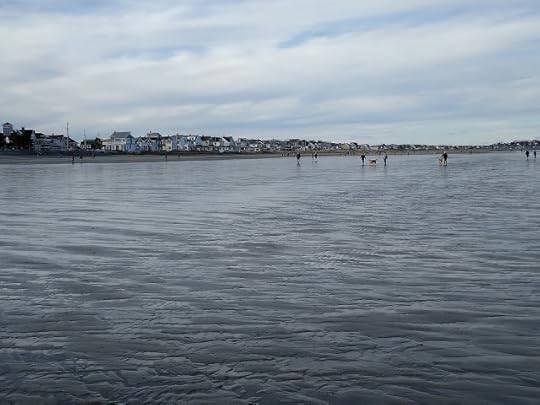
Anne and I took part in the old tradition of taking a good long walk on New Year's Day. This year we went to the nearest sandy beach that offered a wide expanse for walking, Nantasket Beach in Hull, Mass. That shoreline walk provided the impetus for my poem "The Ocean's Voice," the first poem appearing in my contribution to the February issue of "Verse-Virtual."
The two following poems "Storm Coming" and "I'm in Tears" also have a seasonal setting, though "Tears" is a personal testimony to the power of music.
Here's The Ocean's Voice
Not simply words, even the sculpted words of
scrappy screenwriters,
but more like Zen meditations of surf upon the shore
Child that once was, old man who now relives as ritual
what once was adventure
Ears, thoughts, cells cleansed by reports of a timeless pulse
Heart lifted, feet moving in the wet wintry splay
of a long gray apron,
a stage set grandly enough for continental drift
Days drift with the seasons
Now I wrap flesh in layers of borrowed warmth,
thick as the furs of ancient animals,
and breathe clean ocean air,
the pure product of so much watery soul
and maritime mortality
Tiny creatures ourselves,
earnest as a self-sheltered mollusc,
crawling crablike
to put our toes in the water, if only metaphorically
And withdraw, quite promptly, with an oceanic sigh
Ocean! you were always my mother
And Time, a little stroll on the beach
You can read my other two poems, and the work by any of the 65 other poets appearing in the February issue here Verse-Virtual
January 16, 2023
Welcoming Winter: Poems and a Pic for January
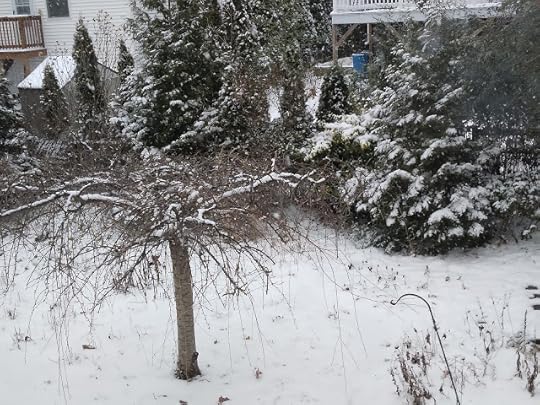
I have three poems in the January issue of Verse-Virtual., the online poetry journal for which I am a very regular contributor: three every month.
This month's contributions include one on the seasons, "Welcome to Winter." One on a harrowing encounter: "The Blind Guy." And One on the need human beings have for one another, titled "Shepherd Me."
Here's
Welcome to Winter
Cover your body with white fat
Grow hair on your neck, the backs of your hands,
ankles, spleen
Smother your skin with the oil of musk,
so effective for reducing unnecessary contact
with others of your own failing species
Cultivate aging machines
They laugh in the face of long-range forecasts
They spit in the wind of progress
They resist as a point of pride
And turn your old car into a dogsled
drawn by the neighborhood delinquents
who refuse to attend those academies of unpleasant demands
offering the acres of the despondency the elders call ‘facts’
Welcome, deep season!
Scrub your windy teeth on the tall and prickly points
of Father Pine, the always acerbic Arborvitae,
and expel your mouth rinse on the gleaming ice follies of yesterday’s lacy network of river and streams
converted now into an arterial network of
just plain freaking cold
Let the ice steam for all comers!
You steam, we all scream
I swallow my fear in huge gulps of repentance
for all that summer love
Embrace me, icicle mother, and all your greenie beaming children
waving frozen wings of beautiful death
To read my other poems, and those of 62 other poems contributing this month, see
December 3, 2022
The Garden of the Seasons: Monthly Reminders
Every year, at year's end we make a calendar for the coming year consisting of photos taken in every month of the preceding year. Here are this year's exemplars. [Quotes come from recent poems.]
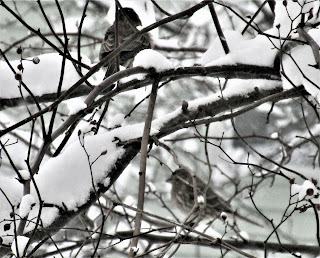 January
January They're flightythey keep flying away from imaginary dangersWho knew the world was so pitted by emergency in the watchesof the wintry morning
from The Birds of Winter
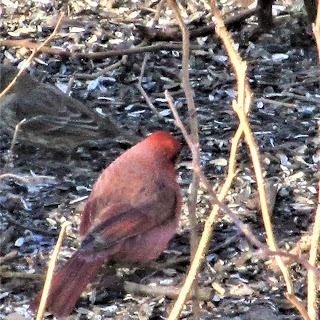 February
February
birds cease their endless ebb and fly to pose for my happy season album close-ups
-- from At Least I Was Alive
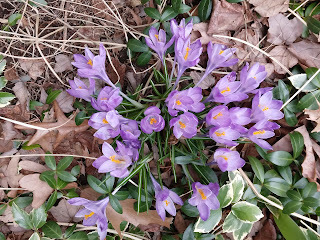
March
Things to do:
Fertilize perennials
Add mulch to hold the water
Plant more native plants
More bulbs? Crocuses? -- from
A Year of the Garden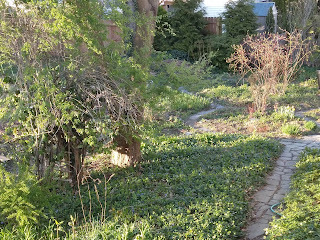
April
Your towering daystar
That tosses spring flowers into the shade
and drowns the trills of April
when nesting songs are on the wing -- from
A Poem About Summer
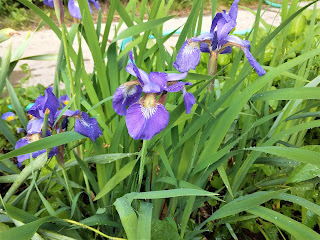
May
They are burying children
On the first days of June
The world is a beautiful place
That we have turned into a slaughterhouse
I ask the Roses to forgive me
I beg the Irises to stay a while longer
And help us become as they are, keepers of beauty--from Slaughter of the Innocents

June
The dream that wakes me in the morning
The good fortune to be here still
The good love
I don’t know, can tulips say that?
Soon it will be roses -- from All We Really Have Are Tulips

July
To be the god I once played at becoming,
Naming the spring,
Demanding a dance of attendance,
All those white and purple flags of allegiance
Rippling in the joyful days
To come -- from Spring Rain

August
August feels a little late
You’d thought that by this latter date
You’d surely have more done
The bees are in the asters
The butterflies are rare
The twilights have a sharper tone -- from Calendar Days

September
September’s songs are mellow
You’re not going back to school
Marigolds are yellow
And resolution is the rule -- Calendar Days
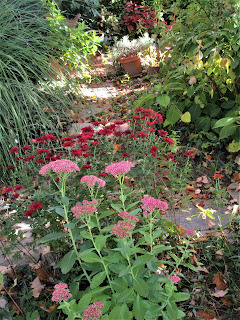
October
Edged by the
late, late bloomers
Mums the word -- Calendar Days
November
I walk the half-bared, spotted earth
Looking for signs of old friends
Who is back for sure, and who is dicey
Which bets I have placed last autumn
Folding their hands, or their tents before I can plan a rescue -- Spring Rain
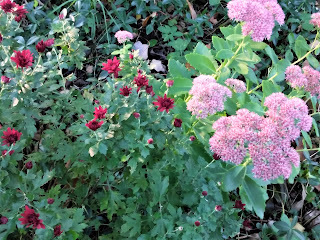
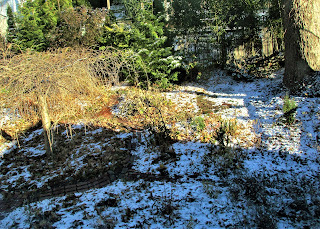
December
What rolls the night, so early in these
last December days,
rolls the earth backwards, onwards,
back into the light,
Oh, rays of light!
And what pours forth, what pours forth --
from The Heart of the Universe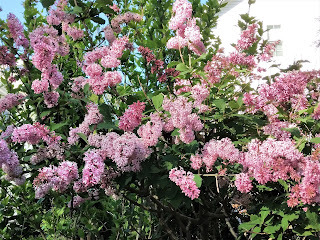
2022
In the life-giving ecstasies of a Berkshire spring
I am thinking not of lilacs last-blooming
in the April of the war’s climactic year,
but of the fall of 1858
When a live-ammo demo at Harper’s Ferry exposed
the US Army as the last defense of slavery --
from Fighting Words
Some More garden photos and a few from The Berkshires (below) I'd like to keep around, just
in case I forget what the world looks like at different times of year.

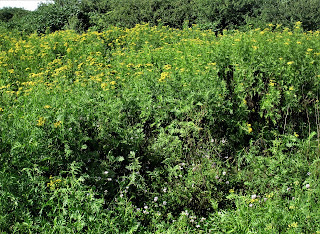
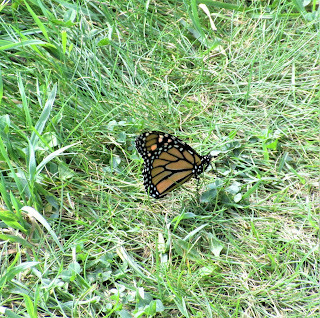


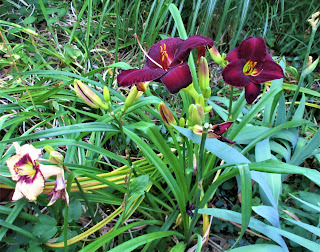



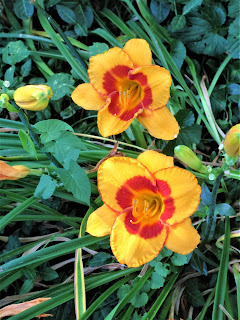


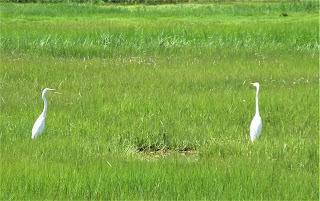
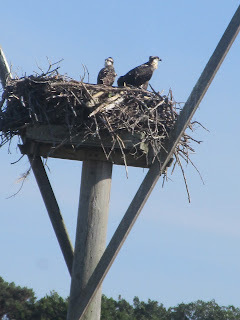
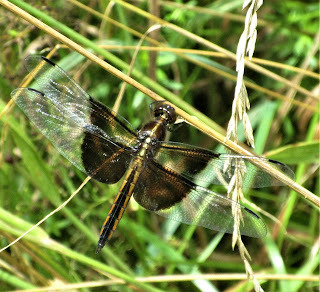
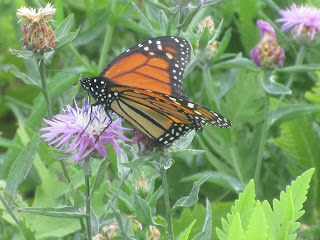
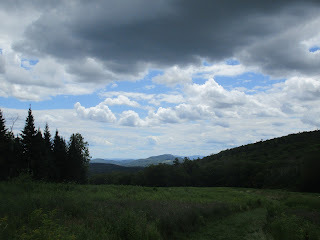
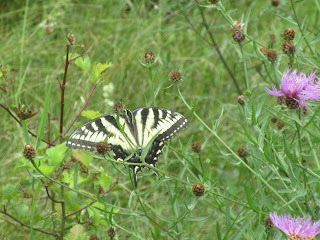
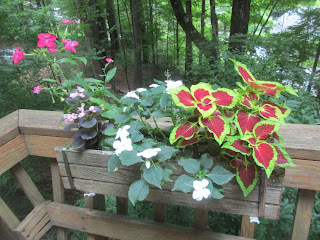
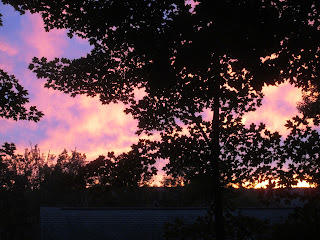
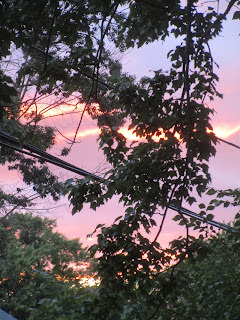

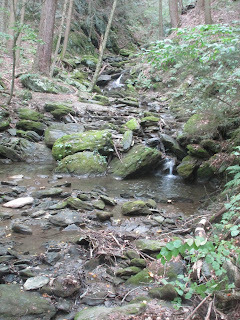
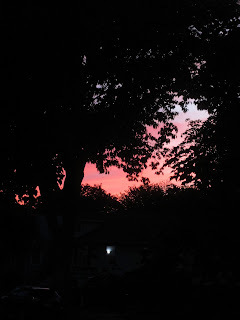

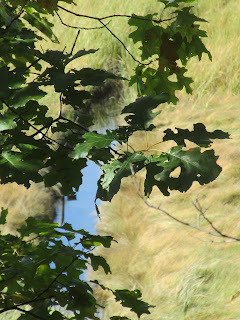


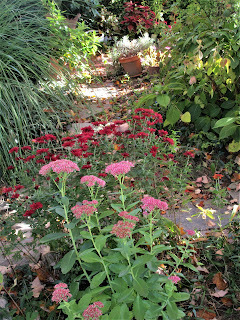
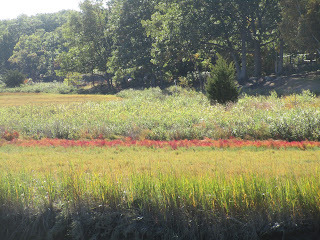

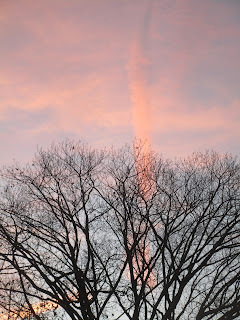
November 4, 2022
The Garden of American History: Things Are Bad Now -- They May Have Been Worse 100 Years Ago
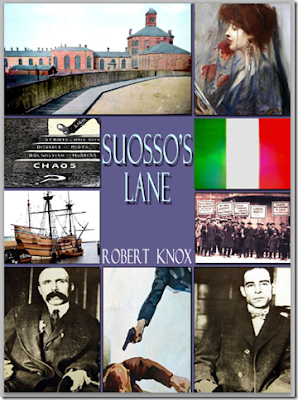
A new book by Adam Hochschild, reviewed in the New York Times this month by Thomas Meaney, offers an early 20thcentury context for America’s current political crisis. Titled “American Midnight,” the book reminds us “that there are other contenders than the period beginning in 2016 for the distinction of Darkest Years of the Republic. By some measures — and certainly in many quarters of the American left — the years 1917-21 have a special place in infamy. The United States during that time saw a swell of patriotic frenzy and political repression rarely rivaled in its history. [The government’s] terror campaign against American radicals, dissidents, immigrants and workers makes the McCarthyism of the 1950s look almost subtle by comparison.”
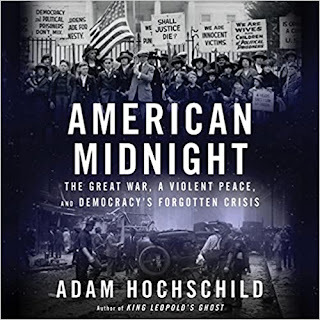 Here's a link to the book review American Midnight
Here's a link to the book review American MidnightThe period that Hochschild writes about is traditionally known as The Red Scare, and it’s the era when two immigrants were framed in Massachusetts for robbery and murders they did not commit that became an international cause known as the Sacco and Vanzetti case.
That cause celebre was the starting point for my novel, “Suosso’s Lane,” which focuses on the Plymouth origins of the case. Bartolomeo Vanzetti was an Italian immigrant who settled in Plymouth’s immigrant neighborhood – North Plymouth, regarded then as a separate enclave – in 1915. He boarded with an immigrant family who lived on a street called “Suosso’s Lane,” hence my book’s title.
Millions of people around the world attended demonstrations or otherwise protested America's racist scapegoating of two Italian immigrants because of their political beliefs. And because of widespread prejudice against the flow of immigrants from Southern and Eastern Europe, including Italians, but also Poles, Russians, Greeks, Jews, Hungarians, Serbs and other Slavs.
"Suosso's Lane" was based on research I initially undertook for the Plymouth, Mass. newspaper I was then working for ("The Old Colony Memorial"). The novel also includes a fictional story about late 20th century history buffs seeking new evidence relevant to the 100-year-old case.
"Suosso's Lane" was published by Web-e-Books in 2016. I still have copies of the 570-page paperback available for purchase. If you're interested in the book, or in the Sacco-Vanzetti case, you are welcome to email me at rc.knox2@gmail.com.
You can also find more info about "Suosso's Lane" at my website robertcknox
November 3, 2022
The Garden of Verse: A Salute to Autumn Skies, A Fond Farewell to the Growing Season, and a Fortunately Minor Fall from Grace
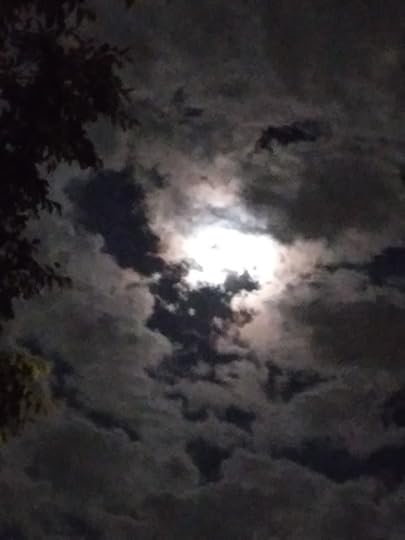
My poems often have seasonal cues. This month I offer a love letter to autumn skies, a fond farewell to another growing season -- despite a less than generous helping of that essential ingredient, rain -- and an account on a near-disaster that has nothing to do with seasons but something to do with me.
Maybe a near-disaster for my body can a be a wake-up call to my brain. Here's my poem about a fall from a piece of exercise equipment caused by simply not paying enough attention to the here and now.
After A Fall on the Treadmill at the YMCA
Is someone trying to tell me something? Someone (or thing) is taking my measure, picking its spots, as I fall flat on my face on that moving staircase People line up for their turn, the Asian mother and her very sensible little boy as I step onto the treadmill I had moments before paused (hadn’t I?), from the side, thoughts (apparently) elsewhere, and am sent flying, face-first and two bounces through the infield. Keep away from machines, a voice whispers, They’re always planning something. Someone is taking my measure. Not, I hope, for a winding suit. The numbers are in, I’m sure, the gang standing at the corner watching the traffic as the rain begins to fall, the final scene sketched on the storyboard. Take your time, boys. No need to hurry the job.
Here's the beginning of my poem about discovering,
much to my displeasure, that I'm out of touch with the phases of the
moon. It's a little like forgetting that the Earth is still
turning.
A Note to Autumn Skies
Don’t think
you can get away with keeping it all to yourself!
So tonight, well after dark, I catch a glimpse
through a living room window of the sky above the neighbor's house
when I’m reaching out to lower a blind,
the only gesture that would put me at the proper angle to see –
Whoa! Is that the moon? Where has it been?
Where have we been?
Lost in a weeks-long clouded dominion,
the misrule of the heavens?
...
Here's a link to see the rest of the poem
And here's an excerpt from my poem bidding farewell
to the home gardening seasons
that got away to swim again
Swiftly!
Swiftly!
Suddenly too chilly this morning to water the plants
Verfallen? Then winter on the lip
of tomorrow
Again, a link: November 2022 V-V
Finally be sure to check out the "Poetic License" column by my fellow fiction writer and poet Robert Wexelblatt on "Thoughts About Writing."You can find that here Poetic License
October 20, 2022
The Garden of Verse: Bio notes and Poems of Growing up
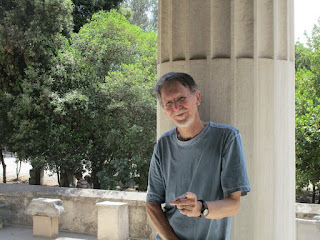 Editor Jim Lewis calls October's special issue of Verse-Virtual " a deeper look at the contributing editors and columnists who have been the quiet foundation of every month's journal, almost from its inception. I invite you to take time to read the expanded bio notes and poems from this group of people I am pleased to call my friends. " The issue features "expanded bio notes and poems." Here's how my bio-note began: "I grew up in a brand-new postwar neighborhood in suburban New York, my childhood a modest example of that era’s unacknowledged white privilege. My parents had experienced Depression childhoods, my father dropping out of high school to support himself. My mother’s family twice lost their home when breadwinners died and she went to work after high school, rather than to college, to support her mother. Because my father was a war veteran, he was eligible for GI loans that enabled him to buy a house in a new neighborhood and paid for his “night school” college education. I attended a couple of newly built public local schools and, when the Ivies were seeking to broaden their student body by accepting students who graduated from a public high school and were not related to alumni, received a needs scholarship from Yale. I majored in philosophy, but realized my true love was literature.
Editor Jim Lewis calls October's special issue of Verse-Virtual " a deeper look at the contributing editors and columnists who have been the quiet foundation of every month's journal, almost from its inception. I invite you to take time to read the expanded bio notes and poems from this group of people I am pleased to call my friends. " The issue features "expanded bio notes and poems." Here's how my bio-note began: "I grew up in a brand-new postwar neighborhood in suburban New York, my childhood a modest example of that era’s unacknowledged white privilege. My parents had experienced Depression childhoods, my father dropping out of high school to support himself. My mother’s family twice lost their home when breadwinners died and she went to work after high school, rather than to college, to support her mother. Because my father was a war veteran, he was eligible for GI loans that enabled him to buy a house in a new neighborhood and paid for his “night school” college education. I attended a couple of newly built public local schools and, when the Ivies were seeking to broaden their student body by accepting students who graduated from a public high school and were not related to alumni, received a needs scholarship from Yale. I majored in philosophy, but realized my true love was literature.In addition to those "expanded bio notes" on growing up in a new postwar subdivision home my parents purchased with a GI loan, my offerings included a poem about the central role "going to the beach" played in my Long Island childhood. A poem about being "Bobby." A poem about the role of "My Mother's Music" in our childhood. And a poem about raising our own children in Plymouth, MA, called "America's Hometown."
Please take a look. Here's the link: Bio Notes and Poems
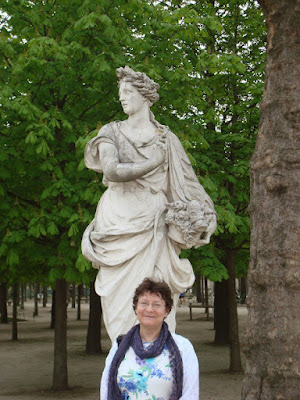 Anne Meyerson, my wife, posing under a statue of the goddess of female strength and wisdom in Paris. Here's a quote from my notes:
Anne Meyerson, my wife, posing under a statue of the goddess of female strength and wisdom in Paris. Here's a quote from my notes: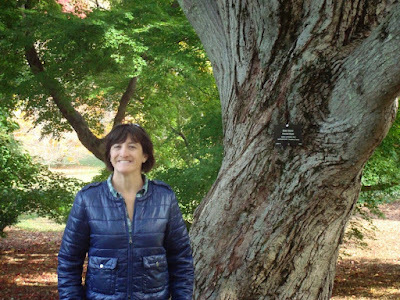
Sonya Meyerson-Knox, our daughter, who lived and worked in Lebanon after graduating from Mt. Holyoke College. From my poem "America's Hometown": At the corner of Massasoit and Mayflower,/ where Winslow relieved a sachem of a serious hurt,/ we settled in a white-wood tower/ to raise our kids on Plymouth dirt."
we settled in a white-wood tower
to raise our kids on Plymouth dirt... "
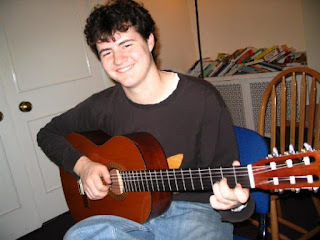 Saul Meyerson-Knox, who earned a master's degree in classical guitar performance.
Saul Meyerson-Knox, who earned a master's degree in classical guitar performance.From that same poem:"Our young spread their wings in open space.
We kept them warm with history tales,
moral precepts performed with passing grace:
Uplift the Fallen, Save the Whales. "
Sonya visiting with her grandmother, my mother, Jean Doris Congreve Knox. This is from my poem
My Mother’s Music
Debussy? my wife guessed.
Rachmaninoff, I suggested.
Both names sat at times on the plinth above my mother’s keys,
certain moments, themes, quick-stirring romantic throbs,
the instant cereal of childhood’s stirrings emerging, here again
all these decades after those first imprintings.
The babyduck follows ever after –
and followed whatever else she played...
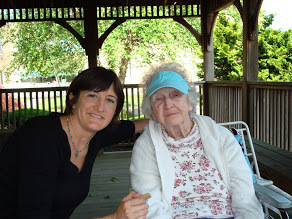
Please take a look. Here's the link: Bio Notes and Poems
September 13, 2022
September Poems: A Time to Reap, and A Time to Worry
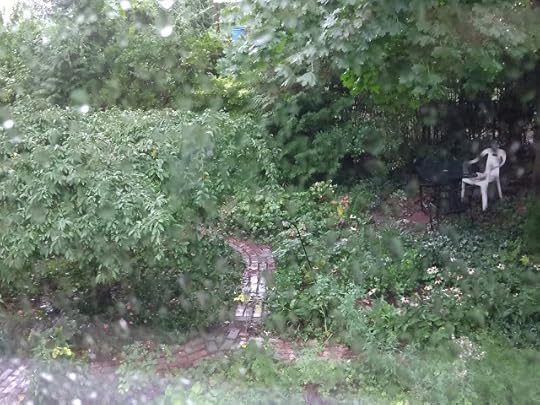
September. a time to reap a time to remember, a time to celebrate, a time to refrain from celebration... and as in the photo above, to watch the rain fall on the garden.
I have three poems in the September 2022 issue of Verse-Virtual, "Time Out," about catching Covid...Here's the first stanza:
Time Out
Covid, we love you
Who else would tell us to spend days in bed,
loving the things we can do
when no one is watching,
no dates on the calendar, no meetings,
when we are fools together, apart,
separate machines for living…
Reading books and napping in different rooms
yet together in all that matters
Getting one’s ass in gear, eventually
Launching sticks up our nostrils
What wicked fun!...
My poem "Goodbye, Summer" can by a conceptual stretch be judged a response to the issue's theme "A Time to Reap"... It begins this way:
Where would summer be if I didn’t pick the berries?
Why would the flowers bloom
if I didn’t venture out to their domain and stare at them each morning?
(and afternoon, and evening, and…)
...
And concludes:
It’s enough to love. It’s enough to have loved.
I do not say goodbye to summer.
It is always summer.
I do not say goodbye to summer love....
Finally, my poem "One Sky," is a tough-love response to the planet's ongoing and accelerating climate crisis. And a stark exercise in finger-pointing at those who continue to ignore the Earth's existential crisis:
Lay down your weapons, soldiers of the night,
and embrace your doom
We bury you in slag heaps, and in Old World cities
encumbered with pyramidal monuments of discarded trumpery,
all the smog of China to feed the funeral pyres
in which your bodies of earth give back to earth that which, ions and particulates, remains strong and fruitful
providing some fertilizer
for whatever may come after ...
To read these poems in their entirety see Verse-Virtual September
I also had a group of politically themed poems in the August issue of Verse-Virtual, titled "When in Rome" (re the history of the Roman Republic); "Social Round" (about July Fourth); and "Proscription List" (a response to America's Taliban-style Supreme Court).
You can find them here: Verse-Virtual August
Verse-Virtual editor Jim Lewis was also kind enough to post one of my poems from six years ago, along with one of his wonderful nature photos on Facebook.You can find it here Osprey poem, pic



